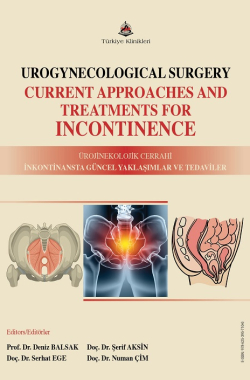POSTERIOR INTRAVAGINAL SLINGPLASTY
Tuna Ayas
Mersin City Training and Research Hospital, Department of Gynecology and Obstetrics, Mersin, Türkiye
Ayas T. Posterior Intravaginal Slingplasty. In: Balsak D, Çim N, Ege S editors. Urogynecological Surgery Current Approaches and Treatments for Incontinence. 1st ed. Ankara: Türkiye Klinikleri; 2025. p.297-302.
ABSTRACT
Pelvic organ prolapse is a urogynecological disease that is common in older women and significantly impacts quality of life. Advanced age, vaginal delivery, obesity, and multiparity play a role in the etiology. Vaginal vault prolapse is seen in 1-2% of hysterectomized patients and 10% of patients who have undergone hysterectomy for prolapse. Vault prolapse can be a serious health problem. Posterior intravaginal slingplasty (infracoccygeal sacropexy) is a minimally invasive surgical procedure developed specifically for apical prolapse by P. E. Petros in 1997. In this procedure, the vaginal canal and vaginal vault are supported by a tension-free polypropylene tape, creating a uterosacral ligament-like effect. Posterior intravaginal slingplasty has gained a place in pelvic organ prolapse surgery thanks to its easy learning curve, high surgical success rate, and rapid surgical recovery. It does not require laparoscopy or laparotomy, and the peritoneum is not opened. It has also been observed to improve lower urinary tract symptoms such as stress urinary incontinence and nocturia. Mesh-related complications (rupture or erosion), bleeding, hematoma, rectal injury, bladder injury, chronic pelvic pain, dyspareunia, sciatica, infection, and abscess formation can occur. Other frequently used surgical procedures for vaginal vault prolapse include sacrocolpopexy (abdominal, laparoscopic, robotic) and sacrospinous ligament fixation. Sacrocolpopexy is a challenging surgical technique with a high success rate. Sacrocolpopexy requires longer recovery and hospital stay than the other two procedures. Sacrospinous ligament fixation can be performed without the use of mesh, eliminating the complications that may arise from it. Buttock pain, sciatica, and dyspareunia may be more common with vaginal posterior intravaginal slingplasty and sacrospinous ligament fixation compared to sacrocolpopexy. Of the three methods, posterior intravaginal slingplasty is the most common complication of mesh. Mesh complication rates have been observed as high as 20%. Over time, due to the high rates of mesh complications seen with this method, other pelvic organ prolapse surgical methods have been preferred. Currently, it is only applicable to a limited number of patients.
Keywords: Pelvic organ prolapse; Posterior intravaginal slingplasty; Infracoccygeal sacropexy
Kaynak Göster
Referanslar
- Abrar S, Mohsin R, Saleem H. Surgery for pelvic organ prolapse and stress urinary incontinence and female sexual functions: A quasi-experimental study. Pak J Med Sci. 2021;37(4):1099-1103. [Crossref] [PubMed] [PMC]
- Marchionni M, Bracco GL, Checcucci V, et al. True incidence of vaginal vault prolapse: thirteen years of experience. Journal of Reproductive Medicine for the Obstetrician and Gynecologist. 1999;44(8):679-684.
- Petros P, New ambulatory surgical methods using an anatomical classsification of urinary dysfunction improve stress, urge and abnormal emptying Int Urogynecol J Pelvic Floor Dysfunct 1997;8(5):270-7. [Crossref] [PubMed]
- Sivaslioglu A, İlhan TT, Aydogmus S, Uzun M, Dolen İ The comparison of the anatomical and symptomatic outcomes of sacrocolpopexy and posterior intravaginal slingoplasty. İnt Urogynecol J. 2011;22(11):1363-8. [Crossref] [PubMed]
- Petros PE, Vault prolapse II: Restoration of dynamic vaginal supports by infracoccygeal sacropexy, an axial day-case vaginal procedure. İnt Urogynecol J Pelvic Floor Dysfunct. 2001;12(5):296-303. [Crossref] [PubMed]
- Farnworth BN, Posterior intravaginal slingplasty(infracoccygeal sacropexy) for severe posthysterectomy vaginal vault prolapse-a preliminary report on efficacy and safety. İnt Urogynecol J Pelvic Floor Dysfunct. 2002;13(1):4-8. [Crossref] [PubMed]
- Sivaslioglu A, Gelisen O, Dolen I et al, Posterior sling(infracoccygeal sacropexy): an alternative procedure for vaginal vault prolapse. Aust N Z J Obstet Gynaecol. 2005;45(2):159-60. [Crossref] [PubMed]
- Foote AJ, Ralph J, Infracoccygeal sacropexy Aust N Z Obstet Gynaecol. 2007;47(3):250-1. [Crossref] [PubMed]
- DeLancey JO, Anatomic aspects of vaginal eversion after hysterectomy Am J Obstet Gynecol. 1992;166(6 Pt 1):171724; discussion 1724-8. [Crossref] [PubMed]
- Smajda S, Vanormelingen L et al, Translevator posterior intravaginal slingplasty:anatomic landmarks and safety margins Int Urogynecol J Pelvic Floor Dysfunct. 2005;16(5):364-8 [Crossref] [PubMed]
- Hinoul P, Vanspauwen R, Smajda S, Roovers J-P. The posterior intravaginal Slingplasty treatment for apical prolapse: 3 yeras experience in a single centre setting Facts Views Vis Obgyn. 2010;2(1):1-8.
- Hefni M, et al. Morbidity associated with posterior intravaginal slingplasty for uterovaginal and vault prolapse. Arch Gynecol Obstet. 2007;276(5):499-504. [Crossref] [PubMed]

